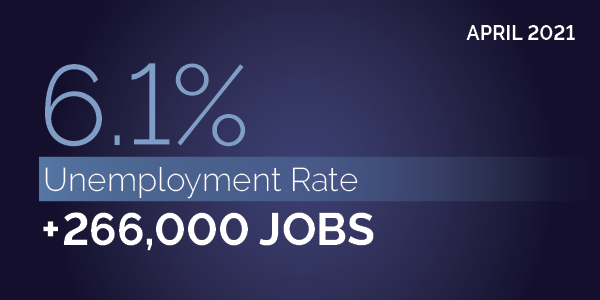
The economy added 266,000 jobs in April, according to the latest report from the Bureau of Labor Statistics. At 6.1%, April’s unemployment rate didn’t change much from March. In short: We’re on the right path, and we need to get more Americans back to work. There’s always a lot of data in these reports, so here are five numbers to help you make sense of the latest statistics.
500,000
April’s report continued a strong trend of growth. Over the last three months, the U.S. economy has added an average of more than 500,000 jobs per month. Given the size of the employment gap, this is great progress in filling that hole.
8.2 million
We’re making gains – and we’ve got to make more to get back to pre-pandemic levels. Employment in local government education, for example, rose by 31,000 in April, but it’s still 611,000 lower than in February 2020. Nationally, we’ve still got 8.2 million jobs to regain as part of the recovery, and we still need strong policies to help get people back to work. The American Rescue Plan has already provided economic relief to struggling families and communities, and reopened schools across the country. And the Biden-Harris administration has set a clear path for continued progress.
9.7%
As I’ve observed before in this space, averages don’t tell the whole story, and an unequal recovery is not a universal recovery. In April, the unemployment rate for Black workers rose to 9.7%, while the white unemployment rate dropped to 5.3%. An inclusive recovery will benefit all Americans. Building on the progress we’ve already made and focusing on solutions that embrace growth and equity will ensure that the impacts of recovery are felt throughout the country. As we invest in America’s workers, we must also address longstanding and persistent systemic inequities.
331,000
This month, we saw a significant increase in the leisure and hospitality industry – another indicator of optimism and a return to “before times” behaviors and business practices. I’ve noted before that the leisure and hospitality industry was hit particularly hard by the pandemic, and it’s still 2.8 million below where it was in February 2020.
-25%
Sometimes a negative can be a positive. In April, we saw a 25% decline in folks who were not looking for work, or had completely left the labor force, due to COVID-19. This contributed to an increase in the labor force participation rate. In fact, it was the largest share of people looking for work since August 2020. More people looking for work means people are feeling positive about the country’s direction and the opportunity for economic growth.
Last year we witnessed the effects of a global pandemic. This year we see the effects of a historic investment in education, infrastructure and the American workforce. As Americans return to work, the department is ready to help create good jobs, strengthen the middle class and empower workers to build an inclusive and robust recovery.
Janelle Jones is the chief economist of the U.S. Department of Labor.

 U.S. Department of Labor Blog
U.S. Department of Labor Blog